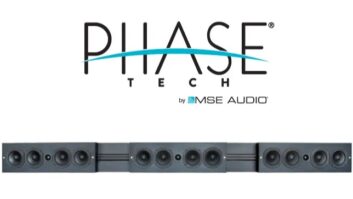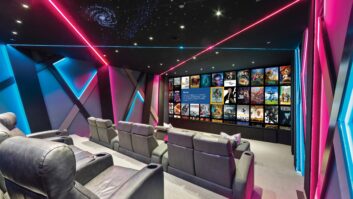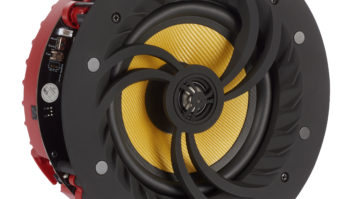Secaucus, N.J. — Panasonic announced March availability and pricing of a quartet of active soundbars and three CD-equipped compact audio systems launched at International CES.
The expanded soundbar lineup consists of four models priced from a suggested $179 to $399, up from 2012’s three models priced at launch from $229 to $399. The new soundbar lineup is sized for 42- to 65-inch TVs, whereas the 2012 line was sized for smaller screens.
The three one-piece, all-mountable SC-HC microsystems are priced from $99 to $249. All three feature Apple’s Lightning dock connector and Made for iPod/iPhone/iPad USB. The top two models add stereo Bluetooth, and the top model adds Apple’s AirPlay and Wi-Fi.
In launching four soundbars, Panasonic equipped all models with Dolby Digital and DTS 5.1 decoding and Dolby Virtual Speaker, which simulates surround sound from front speakers. All bars also feature stereo Bluetooth.
The top two soundbars, like select 2012 models, are convertible, or multi-positional, models. Those two models, the $399-suggested SC-HTB770 and $299 SC-HTB370, can be placed horizontally like a traditional soundbar, or their left and right speaker complements can be detached to create two freestanding vertical speakers. The bars can be wall-mounted or placed on the TV’s stand, wall unit or credenza. Both bars come with a separate 12.2 by 1.75 by 7.4-inch set-top controller/switcher.
The top model features 3.1-channel speaker complement, three HDMI 1.4a inputs capable of accepting 7.1-channel PCM, one HDMI 1.4a output with audio return channel, two optical digital-audio inputs, dialog level control, a mode to add dialog clarity, and automatic gain control to level out abrupt changes in sound levels when a TV program switches to a commercial. Neither comes with IR blaster.
In the top model, each speaker channel is rated at 3×25 watts from 120Hz to 20kHz with 1 percent THD. The left-right speaker complement feature three-way configuration, including a super-tweeter, and the center channel features two-way drivers. The bass-reflex subwoofer features 6.5-inch down-firing driver and 40-watt output at 60-120Hz with 1 percent THD.
The $299 SC-HTB370 features the same left-right speaker complement as the $399 bar but lacks center-channel drivers and lacks HDMI inputs and output. It adds an analog RCA input. Left-right channel output is rated the same as that in the $399 model, and the subwoofer is also the same.
The SC-HTB770 will be available in black and silver. Both models feature stainless mesh design.
The other two models in the soundbar lineup are the one-piece $179-suggested 2.0-channel SC-HTB65 and one-piece $199 2.1-channel SC-HTB70, which features embedded subwoofer. Both lack separate set-top controller/switcher. Both models feature one optical digital input for TV audio and one analog RCA input to connect to a Blu-ray player. Both also feature dialog-level control, clear dialog mode, auto gain control, and 2×16-watt left-right channels rated from 100Hz to 16kHz into 6 ohms at 1 percent THD. The HTB70’s integrated subwoofer is rated at 28 watts, and the HTB65’s sub is rated at 15 watts.
The $179 SC-HTB65 can be mounted on a TV stand or on the wall because it rotates by 90 degrees. The SC-HTB70 can be set up to fire at four different angles to accommodate placement at different heights. A built-in sensor detects the bar direction and switches the bar’s acoustic characteristics for best sound.
In tabletop audio, the three new microsystems are the $249 SC-HC58, $149 SC-HC38 and $99 SC-HC28.
One features AirPlay, two feature stereo Bluetooth, and all three have Apple’s Lightning connector for iPhone 5 and fifth-generation iPod Touch connections, while the $99 model also connects via Lightning connector to the Lightning-equipped iPad Mini, company spec sheets show. All three also feature Made for iPod/iPhone/iPad USB ports to connect to Apple’s other mobile devices. And all three have an FM tuner.
The top two feature motorized sliding door that covers the CD mechanism and a Lightning-docked iPod/iPhone. The $99 model features motorized sliding door that covers only the CD mechanism. All three have two full-range drivers, but the top two models add dual passive radiators.
The top two can also be used with Panasonic’s streaming-music app for Apple and Android devices. On the mobile devices, the app lists all available Bluetooth, DLNA or AirPlay speakers from Panasonic and sends music wirelessly to them.
The $149 and $249 models feature Bluetooth and Bluetooth Remaster technology, which restores frequencies lost during Bluetooth transmission. The $249 model adds AirPlay with Wi-Fi.
The top two models, which can be wall-mounted via included brackets, are rated at 2×15 watts from 20Hz to 20kHz with 1 percent THD. The $99 model is rated at 2×2.5watts from 60Hz to 20kHz at 1 percent THD.
Prices and availability dates for three NE (Network Era)-series tabletop speaker systems will be announced in a few weeks, the company said. They are the company’s first three tabletop audio products to incorporate three wireless technologies — Apple AirPlay, DLNA networking and stereo Bluetooth — in one chassis. They also incorporate Wi-Fi.
In other audio developments, the company is carrying over two 5.1-channel HTIBs from 2012 without introducing new models. The two carryovers include the SC-BTT195 with tallboy left-right front speakers, optional Wi-Fi, one HDMI 1.4a input and HDMI 1.4a output with audio return channel (ARC). The top-end BTT490 offers improved left-right speakers, two HDMI 1.4a inputs and embedded Wi-Fi. They launched last year at a suggested $499 and $499, respectively. The latest pricing wasn’t available.
Both feature 2D-to-3D conversion from 2D DVD and Blu-ray discs, access to Panasonic’s portfolio of streaming Internet audio and video services (called Viera Connect), Skype video chat with optional webcam, and HDMI standby passthrough, enabling audio and video from a connected set-top box or game console to pass through to a connected TV even when the HTiB is off.
Both also feature DLNA technology for streaming audio, video and pictures from a compatible networked PC. Other new features include web browser and ability to up-convert 2D Internet-streaming services and networked-PC video to 3D.
3D Cinema Surround post-processing technology adds height channels to each speaker and makes sound jump out toward viewers when objects in a 3D video program jump out of the screen.
The HTiBs also dock with iPods and iPhones.













